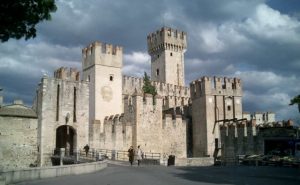Sirmione Castle
The castle dates back to the mid-thirteenth century, with towers and crenellated walls and was a strategic base for the control of the lake for the Scaligeri.
Sirmione Castle was wanted and built by Mastino I of Scala family in place of what, according to the Orti Manara in the fifteenth century, was to be the Roman port, moving the fortress from the hill of Cortine, part of the most extensive Roman fortifications that they included the whole island of Sirmione and ending at the Roman villa. The castle was built mainly in two moments: the first starting from the keep with the first wall, the three towers and the two drawbridges, one towards the village and one towards the peninsula on the outside of the fortification; the second, after about a century, with the addition of the two “external” courtyards and the wooden dock, at that time; when Sirmione passed to the Serenissima in the early fifteenth century it was further fortified, even replacing the Scala wooden dock in the current one. To confirm the different periods of construction there is also the difference in the battlement of the dock that, while for the first part of the castle are the classic Ghibelline merlons with dovetail of the Scaliger, in the second they are a “lance base”. Inside the oldest part there is a portico where a Roman and medieval lapidarium is set up, a staircase that can be reached by a drawbridge and leads to the walkways on the walls. The entrances are equipped with different closing systems, from the drawbridge to the metal shutters and in more recent times from a double door. Until the 16th century Sirmione remained a strong point for the Scaliger defense, until Peschiera took over the role of. Today, after several restorations, the Scaligero Castle is in good state of conservation, the last opening of the walkways along the dock and night lighting, new 2018.

